A get together with Alexis Ravelo
Morning rises over the city of Las Palmas in Gran Canaria. Another morning, apparently quiet if one has the chance to see the sea from his window and witness the swinging of the waves and the trade winds, which allows you to guess there won’t be any low fog (or panza de burro) today.
If Eladio Monroy would stop by the bar Casablanca to have his coffee and read the paper as usual he would find some headlines that would make him remember some of the messes into which, without even meaning to, he sometimes walks.
According to one of the newspapers it seems like a big successful business man from the islands was negotiating with the director of another newspaper while a person close to the latter was doing a job that might compromise the possible agreement that they were handling. Apparently at the same time, surely on another quiet morning like this one, somebody close to the nation’s Government and also a successful business man, had written on his diary something like “topic: director and close person, clean cut”. And to mess things up even more, some other local and national papers were saying that the Public Prosecutor’s office was investigating that person close to the director of the paper for, allegedly, stopping performing his job so not to slow down the mentioned deal. The thing gets complicated and, in order to have a global spectrum of the mess, Eladio Monroy should have been able to access some device that would allow him consult the digital press.
Let’s leave it there for now, finish our coffee by the window and let the imagination fly a little longer. We cannot know for sure what´s going on inside the head of the hero of Morir Despacio, but for the sake of the imagination, let’s say he grabs his mobile phone and puts it on the bar while he starts lighting a cigarette, takes it off his mouth reluctantly remembering the prohibition, and decides to take his last sip of coffee without taking his eyes off the screen. Finally, he makes up his mind and dials.
- Hey, Alexis – he spits without even saying good morning – what fucking mess is this?
Funny enough, that is the same question we’ve asked him.
It isn’t nice siding with the evil character, that’s what we are told when we are young, but we all feel like doing it sometimes. Escaping is more fun than chasing, at least inside the fiction within children’s games, books at night, the movies, and of course, this is something writers know very well. Excessive kindness can be as suspicious of lack of virtue as the lack of wickedness, equilibrium is complex. Girls like bad boys because there mst be something good inside them. Parents like good boys but not that good that they seem dumb, too much goodness must hide something bad.
We meet Alexis Ravelo for this interview at the most noble square in the city, Santa Ana, opposite the Cathedral, within the most cultured and posh quarter. Area of museums, art galleries, and expensive restaurants in which some of the characters in his novels have lunch, mainly politicians and business men whose digestions will be reflected in the official bulletins of the region, town councils and local entities. A few meters off the square lives Diana Padrón, accidental heroine in Las flores no sangran. Accidental because being kidnapped by a bunch of rascals who wanted to fix their lives with a shoot of Euros was probably not in her plans.
Some of those rascals are inhabitants of Ciudad Alta, and that’s where we are headed with Ravelo, to the quarter of Escaleritas, his neighborhood, where he grew up. This quarter almost a copy of so many others, like Schamann, Las Chumberas or Miller. A boiling pot of stories about common people, people searching for life, who live their days always missing living closer to the ocean, to the beach, or just living. One of those areas where drug addicts where evil until they started disappearing from the streets and the old ladies remembered them like “poor souls, such bad luck they had”. Areas where they didn’t have a pubic library for years but could brag of having theaters that showed westerns or movies with Tarzan but which ended up becoming bingos or supermarkets. They were lucky enough to have basketball courts and some parks where the old people would go for a walk on the winter mornings, the same mornings when other men, those the old people and their carers voted for, go on with their business with ladies and gentlemen in the expensive area of the city.
We walk with Alexis to the public library Dolores Campos Herrero, just on we could consider the border between the areas of Escaleritas and Schamann, a few meters from the square of Don Benito, named after the writer from the Canary Islands who perhaps would narrate, if he lived in this island now, his Fortunata y Jacinta of these areas.
This seems to be one of the goals Ravelo has set for himself, to narrate the daily life through extraordinary events, putting on the same stage characters that would rarely address each other in real life. But we wanted to talk to Alexis about evil, its reflexion within literature, noir fiction, within his novels and his characters.
We don’t know whether Monroy, the almost always voluntary hero in many of his works, would agree with the definition the author makes of himself but, in any case, and with the creator’s permission, we can guess that this time he would say it’s none of his business, that curiosity killed the cat, that he better know what he writes. He’d say he’s neither good nor evil, what the hell, he lives and lets live, cooks, reads, drinks coffee and smokes and sometime gets into some kind of trouble Ravelo needs to fix. That is, what we could define, with his permission, as a good person, in the best sense of the term.
Philip Zimbardo says in his essay about evil, The Lucifer Effect – which since we are speculating here we can guess the former chief engineer must have read in one of his journeys – that “keeping that dichotomy between Good and Evil also exempts good people of any responsibility”. Maybe, that who crosses the barrier, who faces the responsibility, is the one who interests us the most. That person who dares to participate even beyond legal terms, with a rule book that as readers we reject in some pages but agree with a few pages later, that’s the most attractive character. In the novels by Ravelo, it might be one of our neighbors or one of our most beloved politicians or business men. And, hey, it’s all clearer that when you read it on the press. Poor souls, a the old ladies would say, those bad men surely also have their little heart. In Ravelo’s novels sometimes they do, sometimes they don’t. Rich people, evil people, as another old lady would say.
Islands surrounded by dunes on every side except one, called the sea. The heat suffocates them, the sandy haze overwhelms them and exhaust their lungs and the sea, always present, is prison and escape. The sea is the last sight for the dead, the dead end fort he murderer, the way of scape for the fugitives, the horizon in which to reflect and let the eye wander amongst merchants and sailboats. The city, mainly, but also the Island, where Ravelo’s characters develop themselves, is shown as a prison in the first few lines. Who would think of dealing with certain business in an island? Where to go if something goes wrong? But, funny enough, it is also drawn as the small kingdom of freedom, so well limited and safe, where the go-getters feel confident imagining there’s nothing beyond and where the powerful men can do and undo as they please, far from the rest of the world, that is, the law.
“Islands are different worlds” said Reina María Rodríguez and she was right. Ravelo seems to want to prove this in his novels, where the physical and human landscapes transmute from one page to the next, from the elegant quarter founded in the years of the Conquest, to the English quarter where politicians and business men live, up to the streets in Ciudad Alta where everybody else lives. The city island is one more character that accompanies the heroes, showing them the way, almost dictating actions, giving them different lights, temperatures and smells. The fresh air and the soft light of the quarters higher than Guiniguada, residence of the most powerful. Heat and haze over the port, the park, where anything happens but almost never. The stink of the streets with the hookers, bored during the day and so miserable at night.
Other writers from these lands shouted they wanted to leave and when some of them left they then shouted they wanted to come back. Not only writers but sculptors, painters of course, also academics, professionals and some other mortals who, having read Arozarena or not, also foresaw their island was experiencing a slow and sweet death, as if the’d cut its veins.
Yes, the islands are apparent and contradictory worlds, like Monroy, like the little go-getters from the quarters that might equally beat you up or say “fuck, man, I really love you”. Like the powerful men who destroy the landscape and the worker’s rights with the pride of creating new jobs and progress on their land, like the politicians who get emotional quoting poets they haven’t read, remembering native heroes or conquistadors, opening a new road that will finally get together people from here and there, while they get tearful with the little envelope full of cash they just put in their pocket.
And just like that, they all jump up with a goal pass to Valerón and dance with the Gran Combo during Carnival, all together, all at once, once. We are all Artemi. All. Iniesta. We are all a bit English, those who built the port and put a banner on the side of the hill of La Isleta where it said “Welcome To The Canary Islands”. A bit Nordic, from whose boats beautifully white women would disembark. Also Portuguese, who left us the art of diving and mojo. And who doesn’t want to become a Cuban when they grow up? who isn’t proud of Bolívar, who tore Nelson’s arm apart? Who isn’t suspicious of carrying African or Sephardi blood? Who can tell the difference between a Palestinian and someone from the Canary Islands laying on the same beach, making jokes. We’ve all sailed through the seas, at least at the beginning, when the verb was only lava and then came the flowers. And we’ve welcomed people who’ve sailed through the oceans, Indians, Koreans, Africans, Arabs, Europeans, it doesn’t matter, the islands are apparent and contradictory worlds, right? You too? So come in and stay, you’ll be fine here. EL Salvaje coming back home, Carmita feeding Carmelito, Déniz watching everything stays the same, El Yunque and El Martillo going on with their businesses, Lola escaping. They are all this town, this island, every island. All of them creative in which they can do best, apparent and contradictory people, wandering about the books by Alexis Ravelo, leaving us some clues of what we are like, what this land is like.
We end our rendezvous with Alexis Ravelo the same way we started it, smoking with that contagious joy that comes when three smokers meet (in this case), and by which you almost end up saying “hell, you too?”. Talking about anecdotes from our neighborhood, a little about politics and journalism, and specially about books, movies, music. We talk about Agustín Espinoza, Bolaño, about the dialogues in 2666, about the adventures of detective McNulty in The Wire, about the music in Treme. We say goodbye with the feeling of having known him for a long time, or as if we’ve read about his life, about his wanderings.
Any similarities between reality and the events described here is pure coincidence. All places, characters and news are real including the novels and Alexis Ravelo (sitio web), of course, but like the islands, these articles are sometimes apparent worlds, surrounded with doubts everywhere.
We would like to thank the workers at the Dolores Campos Herrero Public Library for kindly allowing us to use their installations to produce this article, and Alexis Ravelo for accefting our offer and taking a risk with this first issue of our publication.



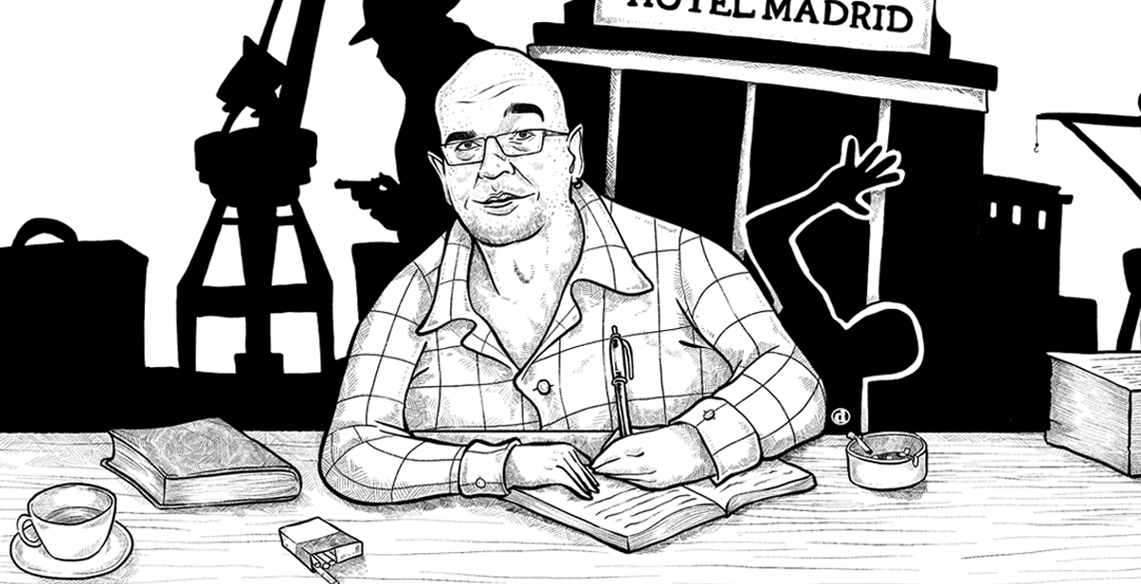
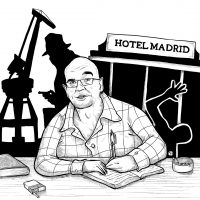
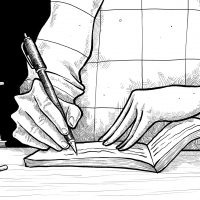
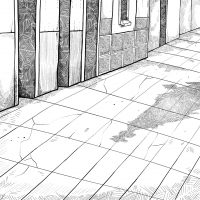



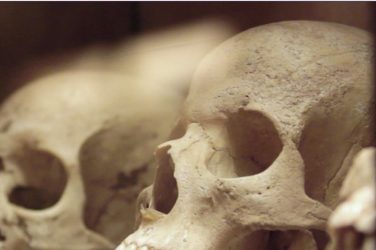
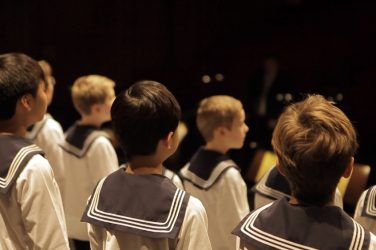

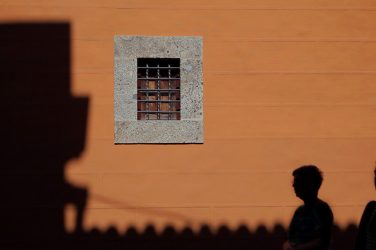

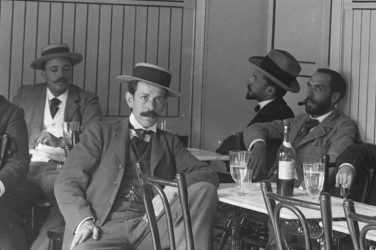

Mostrar comentarios (0)